

| Trade log-in: | HERE | |
| Get password | Forgot password | ||

2015.3 | 2015.2 | 2015.1
2014.3 | 2014.2 | 2014.1 | 2013.3 | 2013.2 | 2013.1 | 2012.3 | 2012.2 | 2012.1
2011.3 | 2011.2 | 2011.1 | 2010.3 | 2010.2 | 2010.1 | 2009.3 | 2009.2 | 2009.1
2008.3 | 2008.2 | 2008.1 | 2007.3 | 2007.2 | 2007.1 | 2006.3 | 2006.2 | 2006.1
2005 | 2004 | 2003 | 2002 | 2001 | 2000
In this issue, during this season, as we look for light, we offer many things to brighten darker days. And we take this opportunity to thank our readers, clients, and contributors for their attention, patronage, and gifts. In this time of gift-giving, we ask you to maintain the post-flood work in Pakistan done by Doctors Without Borders, or the alternative we offered in September.
After the holidays, we’re looking forward to the world’s greatest gem and mineral show in February. One-stop general information about individual shows can be obtained from the Tucson EZ-Guide.
Pala International will be represented in Tucson as follows. We look forward to seeing our many friends there. Visit the Pala International Show Schedule for future events.
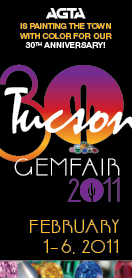 |
Pala joins nearly 100 exhibitors for this annual extravaganza.
Event: AGTA GemFair
When: February 1–6
Where: Tucson Convention Center
Booth: 1016
The event website now features an interactive floorplan allowing you to see who is exhibiting by area of the convention center.
As always, seminars abound. Alan Hodgkinson looks at inexpensive tools that aid IDing gems and gem material in “Getting to Gemmological Grips with Gemstones” and Claire Mitchell presents on a single tool in “Cross-Purposes: Using the Gemmological Polariscope.” Antoinette Matlins offers an extended session of “Gem ID – Parts I and II”—not once, but twice. Lorne Stather discusses “The Blues: Distinguishing Blue Stones That Look Alike” and Gary Roskin recalls “An Evening with the Blues.” Frank Farnsworth discusses “Opal Evaluation and Valuation” and Robyn Dufty takes you on “An Opal Trip Around the World.” Jacques Christophe Branellec and Kathy Grenier give a hands-on look at “Golden South Sea Pearls” and Elizabeth Strack discusses “Developments in Cultured Pearls.” Richard Drucker gives his “Best Buys in Tucson” and Richard Wise prepares you for the sale of your best buy with “Selling Six Figure Jewelry and Gems.” There’s a lot more on the bill, including business topics such as ethical and fair trade, social media marketing, home-based business tips, trends, retailing, cultural aspects, and more on the GemFair Seminar page.
Pala International and two dozen other world-class mineral dealers shack up at a Sonoran Desert resort.
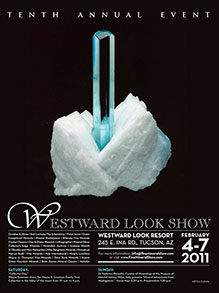 |
Event: 10th Annual Westward Look Mineral Show
When: February 4–7
Where: Westward Look Resort
Suite: 224
See Pala International’s page on the Westward Look Show site.
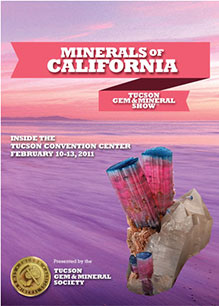 |
TGMS is the largest gem and mineral show in the country. This year’s theme is “Minerals of California,” so it was natural that Pala’s Bill Larson would be asked to make a presentation on the subject.
Event: 57th Annual Tucson Gem and Mineral Show
When: February 10–13
Where: Tucson Convention Center
Booth: Aisle 5 East
We received an updated list of presenters for the 2011 show:
Many shows will offer their own shuttles. View your transit and parking options here. [back to top]
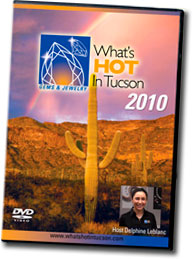 |
Did you know that BlueCap Productions offered, this year for the first time, a What’s Hot In Tucson: 2010 – Gems and Jewelry?
Attention Holiday Shoppers: Friends of Pala International get a 10% discount on any BlueCap order. Just enter the code palaintl when you’re asked for it while ordering.
A little bird told us that BlueCap Productions will offer at Tucson 2011 the first volume in a Collecting Minerals video series. Collecting Minerals: Thumbnails will feature specimens from the likes of Wendell Wilson, Carolyn Manchester, and Rich Olsen, and will fill the screen in 360-degree glory as the collectors reminisce on each piece.
 |
A month after Tucson, BlueCap is slated to release a new What’s Hot. This one takes the viewer to Mineralientage München, Europe’s largest mineral show. The October 2010 show featured some impossibly precarious tourmalines from Brazil’s Minas Gerais, which What’s Hot In Munich captures backstage.
Subscribers to Mineralogical Record will receive their own copies free of charge, with the March–April issue.
  |
| Boas festas from Brazil in vermelho e verde. Palagems.com offers some lovely and affordable heated tourmalines from the country featured this year at the Munich show. At left, a 4.98-carat red rubellite, Inventory #2092. At right, a 9.51-carat green tourmaline, inventory #402. (Photos: Wimon Manorotkul) |
[back to top]
The Gemological Institute of America (GIA) Symposium 2011 research track lineup is up at symposium website.
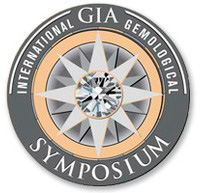 |
Then the research track begins with several keynotes:
Abstract submission deadline is January 10, 2011 and early bird registration ends February 28. The symposium will be held May 29–30. [back to top]
Do not adjust your monitor; you are seeing the mesmerizing effects of zircon. The doubling within this jewel causes the onlooker to see two images in tandem. It’s kind of like crossing your eyes, except the two axes within the stone are doing the crossing to the light. When the two refractive indices or axes separate the light into two speeds, this difference—called birefringence—is manifested as two separate images or doubling. The higher the birefringence, the stronger the doubling.
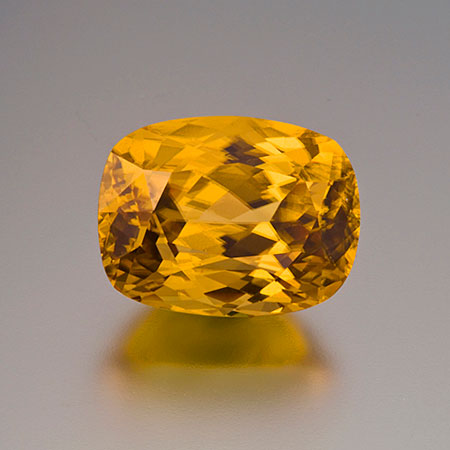 |
| Golden zircon. This 36.79-carat stone measures 19.87 x 15.28 x 11.7 mm. Ask for Inventory #18722. (Photo: Mia Dixon) |
Many gems play with light in varying fashions because of their complex structure and chemistry. Zircon is just another example of diverse optical characteristics that gems display. See our inventory of zircon here.
As mentioned above, gems play with light and produce many wonderful phenomena and properties, but the easiest property to appreciate and understand is color. We see and take the plethora of colors around us for granted everyday. Pure, natural color in gems can be almost surreal, when mother nature produces vivid and pure hues. This suite of gems, below, from Pala’s inventory is a colorful reminder of all the amazing chromatics nature has to offer. Whether you see the pure beauty of these jewels or are intrigued by their unusual properties, they are sure to please.
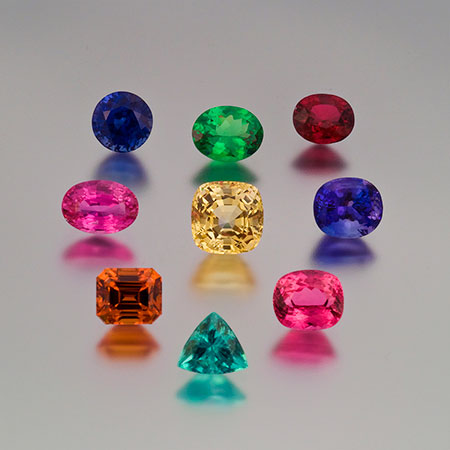 |
| Pleasing to the eye… Color. (Click the photo to zoom in) Row 1: Blue sapphire (2.55 ct. Inv #10127), Tsavorite (2.5 ct. Inv. #18582), Red Spinel (2.37 ct. Inv #16659) Row 2: Padparadscha (3.11 ct. Inv #18036), Yellow Sapphire (5.87 ct. Inv #14877), Tanzanite (3.19 ct. Inv #1762) Row 3: Spessarite (3.32 ct. Inv #13069), Paraiba (1.58 ct Inv #18754), Pink Spinel 3.08 ct. Inv #17388). (Photo: Mia Dixon) |
Interested? Select the inventory numbers above, call, or email us to inquire. [back to top]
Pala International president Bill Larson will speak to a members-only event of The Dallas Woman’s Club, Thursday, January 27, 2011, at 11:00 a.m., at the Club building, 7000 Park Lane. Bill’s topic is “Precious Gemstones: Mined, Refined and Designed.” The Club telephone number is 214.363.8370.
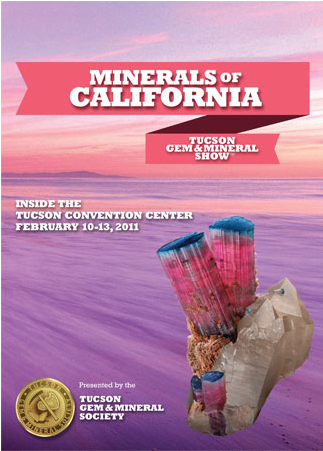 |
| 2 x 2. If you missed Bill Larson’s display at TGMS 2008 (see Mindat.org coverage), which included the “Rabbit Ears” specimen that graces this year’s poster, you’ll have another chance. The 24-cm. tall specimen will be on loan again from the Houston Museum of Natural Science at the 2011 show. It’s from the Tourmaline Queen Mine in the Pala Mining District of San Diego County. |
In keeping with its theme, “Minerals of California,” the 2011 Tucson Gem and Mineral Show will feature Bill Larson speaking on the topic of California tourmalines.
Speaker: Bill Larson
Presentation Title: “Fabulous Treasures from San Diego Gem Mines”
What: 57th Annual Tucson Gem and Mineral Show
When: Saturday, February 12, 2011, 2:00–3:00 p.m.
Where: Tucson Convention Center
Room: Turquoise Ballroom (TB)
  |
| Hard candy. Two stones showing the subtler side of San Diego County pink tourmaline. Much of the material from this area is vivid but not eye-clean—unlike these limpid lovelies, which makes them something special. At left, a pinkish-gold 6.10-carat tourmaline that displays pleochroism when viewed from the table. Inventory #9661. At right, a fancy 5.94-carat pink tourmaline, Inventory #5233. (Photos: Wimon Manorotkul) |
[back to top]
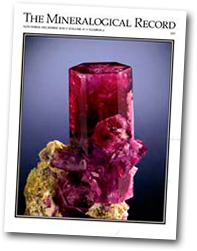 |
In our last issue of our sister newsletter, Pala Mineralis, we featured an abbreviated report from Pala’s Will Larson regarding the 2010 Euro-Mineral & Euro-Gem shows at Sainte-Marie-aux-Mines.
The full report—by Bill, Will, and Carl Larson—has been published in the November–December issue of The Mineralogical Record, and we’re pleased to provide a reprint of it here. It covers four days of highlights from the show
In the reprint, we’ve included some new photographs from Carl Larson.
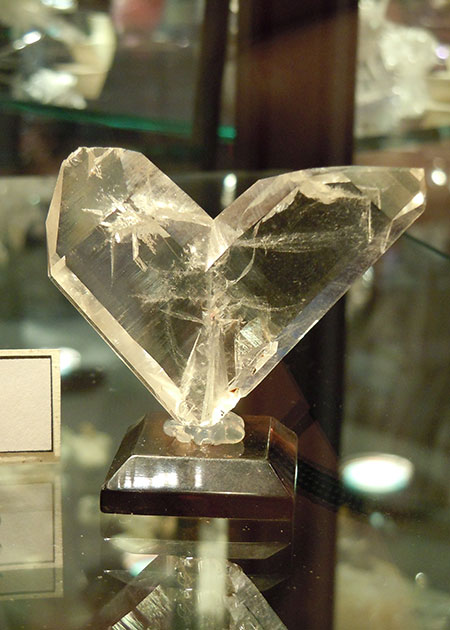 |
| A nice Japan law twin from a special display of quartz from France. (Photo: Carl Larson) |
[back to top]
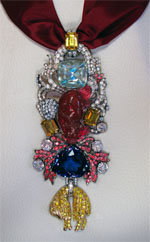 |
| The Golden Fleece plays a part in Secrets of the Hope Diamond. (Photo courtesy François Farges, MNHN) |
We just received word from François Farges, professor of mineralogy and curator of minerals at Paris’s Muséum National d’Histoire Naturelle, that a 52-minute, English-language version of the French Tracking the Blue Diamond, is scheduled for broadcast on Monday, December 20, 9:00 p.m. EST, on National Geographic Channel. The documentary, now titled Secrets of the Hope Diamond, is a co-production of National Geographic US, GEDEON Programmes, and ARTE France.
Meanwhile, Smithsonian Channel has been cabling and streaming its own Mystery of the Hope Diamond, a 46-minute documentary that appears to have some cross-fertilization with “Secrets.” The film was produced for the channel by Blink Films (UK) in collaboration with Channel 4, National Geographic Channel, ARTE, and NHK (Japan Broadcasting Corporation). Actor Kim Bassinger narrates the film, “the definitive story of the gem, mixing history, science and legend,” according to a press release. “It features two exclusive events: the creation of new 21st century setting* selected by the American people and an audacious experiment to reveal the inner secrets of the diamond.”
 |
The documentary also celebrates the 50th anniversary of Harry Winston’s donation of the Hope to the National Museum of Natural History. The next cabling of the film is scheduled for Friday, December 17, 9:00 p.m. EST. For those who don’t receive the channel, it is streamed here, 24/7.
___________
* See Gary Roskin’s interview with the 21st century designer Maurice Galli.
[back to top]
In September, we were sent a photomicrograph of an inclusion in diamond from Isabela Leocadio, and her father Valter Leite, who she describes as a specialist in rocks and minerals.
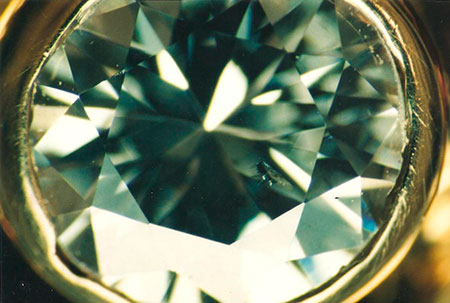 |
| Bugalicious. The inclusion shown at this angle is remarkably, well, entomomorphic. To dispel that notion a bit, see Photo #3 in this report. (Photomicrograph: Dr. Jürgen Schnellrath) |
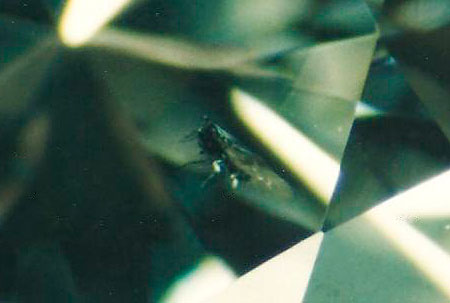 |
When we asked for more information regarding the stone, Ms. Leocadio filled us in:
It is a 0.20-carat natural diamond that is in the graduation ring my father commissioned for my sister, an officer of the Brazilian Air Force. However, when my father found the “insect” inclusion he decided to preserve this special ring and commissioned another one, similar, for my sister’s graduation.
The photo was taken by Dr. Jürgen Schnellrath (German Gemmological Association) in the microscope of CETEM, the Centre for Mineral Technology in Brazil, so the report is in Portuguese. Probably the insect image is a result of inclusions and fissures but this report is not conclusive.
She considerately forwarded us an assessment by John Koivula, who has literally (co)written the book on inclusions, to which he refers (in Volume 2).
Thank you to both you and your father for sending the photomicrograph of the “insect” inclusion in your sister's diamond. It looks very much like a leaf hopper to me. See pages 290 and 292 for two similar looking insects in amber. From the way the inclusion looks I suspect that the “body” (abdomen, thorax, and head) and at least a few “legs” are composed of graphite and or sulfides, possibly a combination of the two. Pressure-formed cleavages appear to make up the “wings.” This “insect” inclusion of course makes your sister’s diamond one of a kind, the only one on our planet, which in my estimation makes it very special.
We’re grateful to Ms. Leocadio, Dr. Leite, and Mr. Koivula for this story. [back to top]
Back in July, Norm Brisson, Colorado Governor’s Chief Administrative Officer, approached the Capitol Building Advisory Committee with a proposal to display the state key in public, under the capitol’s iconic—and soon-to-be-renovated—gilded dome. Last month, after a quarter century of limited viewing, the key went on display.
The key was donated in September 1984 to its brainchild, then-Governor Richard Lamm, by Denver’s Hyde Park Jewelers. “Lamm asked that the key be made after he learned the state didn’t have one,” according to a November 16 story in The Denver Post. The key had been given to the Colorado History Museum, which thereafter kept it in storage.
 |
| Keystones. Note, at left, that the key’s bittings are in the form of snow-capped peaks. See a highly detailed photo here. (Photo: Andy Cross, courtesy The Denver Post) |
The key, measuring about 5 x 2 inches, includes the following components, and took 55 hours of labor, according to its creators.
An elegantly simple reworking of the state seal (usually rendered on concentric circles of red and blue) was crafted in what appears to be vitreous enamel, using a palette that compliments the stones’ hues, chosen for their association with the state flower, the Rocky Mountain Columbine. According to Committee meeting minutes, the key has a value of about $15,000. [back to top]
A superb pigeon’s-blood red ruby from Burma was a highlight of Christie’s Hong Kong sale late last month: 7.04 carats of unenhanced perfection. From the lot description:
These Mogok-type rubies typically possess a red body colour and red UV-fluorescence. In addition, they may contain tiny amounts of light-scattering rutile silk and a swirl-like growth pattern. It is this combination of features which gives these rubies their characteristic appearance. The natural ruby of 7.04 carats described in the above mentioned Gübelin Gem Lab Report possesses a richly saturated and homogenous colour, combined with a high degree of transparency.
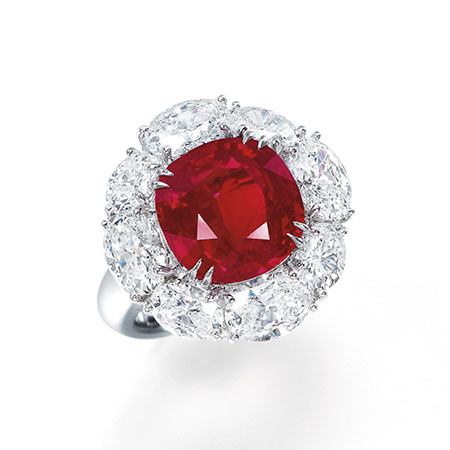 |
| Christmas colors. Just the accessory for Mrs. Claus… (Photo courtesy Christie’s Hong Kong) |
The ruby, mounted in a ring within an oval-shaped diamond surround of unknown total carat weight, brought $1 million above its estimate, achieving a sale price of over $2.9 million. The company it kept included a 14.23-carat fancy intense pink diamond ($23 million), which makes it the most expensive jewel ever sold at auction in Asia, according to Christie’s post-sale notice. The sale itself set a record as well.
The strength of the jewellery market was once again demonstrated in Hong Kong with a record US$78.9m auction, making it the highest total ever for a jewellery auction in Asia and the largest at Christie's worldwide…,” said Vickie Sek, Director of the Jewellery and Jadeite Department, Christie’s Asia.
Even a slightly mismatched pigeon’s blood pair of pendant earrings brought a hefty $2.6 million. Also in the Top Ten were a pair of Burma blue sapphire ear pendants (nearly $1.4 million) and a necklace of thirty graduated Burma rubies with a tcw of 57.48, in a diamond surround. All of these had no trouble bringing in $200–300,000 above their estimates. [back to top]
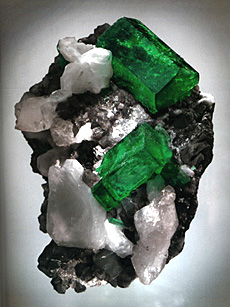 |
| The Yamile emerald specimen from Muzo, Colombia, appears both in Ringsrud’s report and Pala International’s Westward Look Show page. The specimen was photographed by Harold and Erica Van Pelt for Wayne Thompson’s book Ikons. |
Looking for a portable investment? Now might be the time to grab some green, with a market bullish for the beryl. In his recent newsletter, Ronald Ringsrud discusses the breaking of old price-per-carat barriers for emerald. “It used to be that the finest emeralds sold for a maximum of $40,000 per carat,” he writes. That was then; $90,000/ct is now, with a Christie’s Geneva sale, November 17, of The Muzo Emerald, which brought in more than $200,000 more than the stone’s estimate. The last such price punch? In 1985, with a 12-carat emerald “with a spectacular combination of color and transparency.” Ringsrud mentions more milestones, then heralds the dawning of a “new era of stratospheric emerald prices.” And that’s not limited to faceted stones. Ringsrud cites Pala International’s Bill Larson as having observed the same activity in the market for fine mineral specimens.
Ringsrud isn’t the only one spotting a trend. Bloomberg reported last week that former executives of Rapaport Group are creating a commodity fund that would put a new twist on carbon trading. Since the late 19th century, carefully managed diamond production has rewarded the industry with relative price stability. Developments of the late 20th century, which opened up the field to new players, meant new strategies. A rise in 2010 diamond prices of 11 percent, coupled with what the new group—Fusion Alternatives—sees as a “steady decline” in facetable material, has created the perfect opportunity. Bloomberg points to an 8.5 percent production slide (per RBC Capital Markets) between 2005 and 2008, and then a 30 percent tumble last year, during the economic crisis. Fusion sees interest in a new vehicle coming from investors who see commodities as a whole riding a new wave—as a hedge against a cash crash.
The story, however, is sprinkled with history and hand-wringing, from a failed attempt in the 1980s to a recent 49-percent plunge via Diamond Circle Capital. And then there’s the fear that the elusive allure of diamonds might be brought down a notch or two, slumming with soybeans and other commodities.
The jewelry collection of Wallis Simpson, when auctioned in 1987—and today—is “still the most valuable single-owner jewellery collection ever sold,” according to Sotheby’s. It was assembled during Edward VIII Prince of Wales’s courtship of, and marriage to, Simpson, “who was a leader of fashion and the epitome of elegance and sophistication for her generation and beyond.”
 |
The relationship between The Man Who Would Not Be King and socialite Simpson elevated sentiment above station, appealing especially to an American Dream sensibility. The Jewels of the Duchess of Windsor (her title accorded her no privileges) thus were imbued with just the sort of haut-romance that jewelry industry players fear could be blemished by association with crass, fungible goods like coffee and crude.
On November 30 Sotheby’s London offered but a subset of the 1987 collection—but what a subset. The “Panther Bracelet” alone arrests the heart (and, yes, there was one of those, too), as it did for four bidding buyers, until one had set two records, for any bracelet—and any Cartier—at auction. The emerald-eyed cat slinks supplely (see video here) with an articulated body and outstretched paw. A colorful Cartier flamingo clip—of ruby, sapphire, citrine, and diamond—is an example of Simpson’s daring. It made its way home, in a sense, being bought by Collection Cartier. Two jewels of particular personal significance were included in the (relatively) modest 20-lot sale: the famous diamond bracelet of gem-set crosses, which she wore at her wedding, and a heart-shaped brooch with calibré-cut emeralds set in the initials W.E. (the title of Madonna’s second outing as director). See the entire catalog here. [back to top]
Reuters reported on December 7 that Burma’s annual “Mid-Year” gem emporium, held November 17–29, netted $1.44 billion, according to a government official. Some 6,700 traders attended, with 4,000 coming from overseas. Sold were 9,157 lots of jade, 273 lots of gemstones, and 237 lots of pearls. Eleven Media Group reported that 90% of the jade and pearl lots on display were sold. The anonymous source told Reuters, by way of understatement, that the proceeds were the highest from a single sale. The story claims that “[t]his is the first time in five years that the government has indicated how much money has been generated from the emporium.” Perhaps true, but figures have found their way into the press, usually Chinese, as the newly updated running total on Palagems.com bears out.
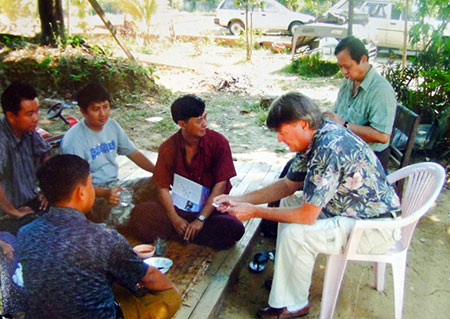 |
| Let’s make a deal. Bill Larson examines the goods as, at right, Han Htun, FGA calmly calculates. |
The story included two other sale statistics, the second of which call for some corroboration:
Officials said trade fairs held in March and October generated 400 million and 700 million euros respectively.
The reconciliation group Network Myanmar had this pithy comment: “These [emporium] results highlight the absurdity of the US JADE Act, which seeks to sanction the trade, but has very little effect.” On November 18, London’s Financial Times discussed the issues surrounding sanctions, following the release of Aung San Suu Kyi. “The first barrier to go is likely to be the unofficial boycott on tourism,” the article stated, while governments put their fingers to the wind.
In our last issue, we noted a rent boom in Burma’s administrative capital of Nay Pyi Taw, site of the November emporium. The Myanmar Times reported this week that hotels as far as 60 km. away were booked for the emporium, which was not held in Yangon as in the past. The article quoted several hotel personnel about their experience. Problem is, the city otherwise is not a tourist destination. Nevertheless, a realtor quoted by Eleven Media Group in an undated story claimed that “[a] boom in the gem market usually has an impact on the real estate market.”
Kachin News Group reported November 18 that a landside at a dump site killed more than fifty people in Mawshan, Hkahku village, at Hpakant, in Kachin State. The dumps from jade mining are a magnet for scavengers hoping to find what the mining operation has missed. The accident killed not only miners but also businessmen warming themselves at a fire, ready to purchase what was found. Such landslides have killed in the past. [back to top]
 |
| Chinaqua. The stocking will be quite stuffed with this 22.99-carat heated aquamarine. Inv #271. (Photo: Wimon Manorotkul) |
China’s official People’s Daily Online, which usually carries carbon copies of gem-related stories from other official sources, recently featured two original pieces of interest.
China’s south-central Yunnan Province is host to “[r]ock layers that may contain diamond and jadeite,” given the fact that the province already has found “over 50 types of gemstones, such as the world-renowned rubies, sapphires, aquamarines, emeralds, tourmalines, Huanglong jade and Xiuyan jade in more than 200 deposits,” per a November 22 People’s Daily Online report. Li Lianju, deputy director of the Yunnan Department of Land and Resources, was quoted as saying that, due to a number of factors, the province could become the world’s “stone cultural center.”
In a December 1 story, People’s Daily reported that “China’s consumer market for imported diamonds now ranks second in the world,” according to China Diamond Forum, which opened in Shanghai on November 30. But it’s a distant second, according to the data presented in the article—less than a third of the U.S. foreign trade in diamond—with Japan coming in third.
  |
| Like a rose e’er blooming. Natural watermelon-hued rhodochrosites from China. At left, a 3.02-carat pear-shaped, Inventory #17701. At right, 5.83-carat cushion-cut, Inventory #17702. (Photos: Wimon Manorotkul) |
[back to top]
— End December Newsletter • Published 12/15/10 —
In this issue, we’re taken around the globe: Jeddah, Tucson, Burma, Sainte-Marie, Paris, D.C., Guatemala, Tibet, Brazil, Beijing, New York, Geneva, Egypt. What a wonderful world...
Be sure to see the news on yesterday’s record-setting sale of the 24.78-carat “potentially flawless” jewel now known as the ”Graff Pink.”
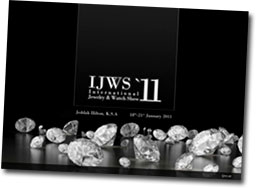 |
| See the brochure for the show here. |
The Kingdom of Saudi Arabia (KSA), relatively unaffected by recent economic troubles, is opening its doors for business, via IJWS ’11, to be held in January at the Jeddah Hilton Hotel. The show’s website pegs estimated jewelry consumption at $7.2 billion. The show expects to attract a wide range of visitors and exhibitors.
Promotional material makes the claim that the KSA local market cannot keep up with demand, and has the highest per-capita consumption of jewelry in the region. Looks like some valuable networking could take place. [back to top]
This year’s Accredited Gemologists Association conference at Tucson will feature an international group, prominent in the field.
The conference will be held at the Marriott University Park. Early registration discount is available. See the AGA website for details. [back to top]
This month we are featuring a spectacular golden sphene from Burma. This dark honey-brown gem is warm and enticing at first glance. Then, when you rotate this stately gem and vary the light, it comes alive, waking up the dazzling dispersion that sphenes are famous for. Throwing all the colors of the rainbow, this jewel is mesmerizing and sure to entertain the veteran collector as well as the novice. Sphene is found all over the world in colors ranging from orange, yellow, green, and brown.
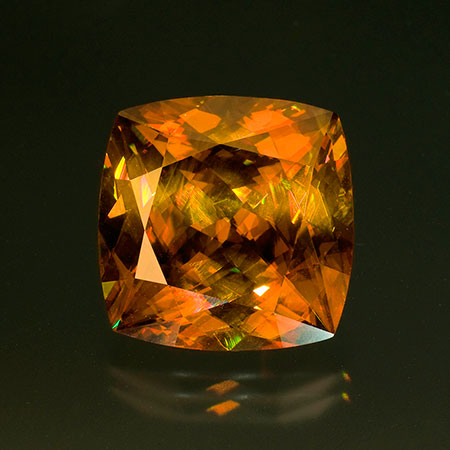 |
| Golden brown sphene. This stone weighs 40.33 carats and measures 20.03 x 20.05 x 12.86 mm. Inventory #18755. (Photo: Jason Stephenson) |
See our full selection of sphenes here.
Interested? Select the inventory number above, call, or email us to inquire. [back to top]
 |
Last month in our sister e-newsletter, Pala Mineralis, we featured an abbreviated report from Pala’s Will Larson regarding the 2010 Euro-Mineral & Euro-Gem shows at Sainte-Marie-aux-Mines.
The full report—by Bill, Will, and Carl Larson—has been published in the November–December issue of The Mineralogical Record.
To mark the occasion, we’ve added some new photographs from Carl Larson to the initial report. See it all here.
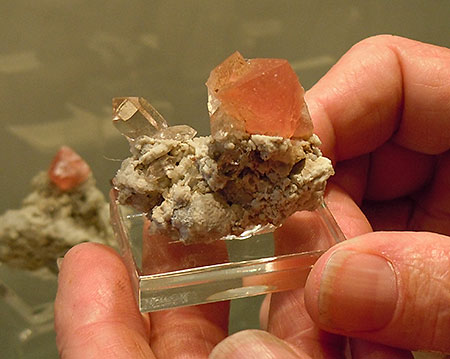 |
| A lovely pink fluorite displayed at this year’s Sainte-Marie-aux-Mines show. See more new photos here. (Photo: Carl Larson) |
[back to top]
 |
On November 9, the Gemological Institute of America (GIA) announced the retirement of Alice Keller, editor-in-chief of the school’s quarterly, Gems & Gemology (G&G), effective January 1, 2011.
Keller was personally selected as editor in 1980 by the late Richard T. Liddicoat, himself editor-in-chief for fifty years, after GIA founder Robert Shipley. Keller took on the role of editor-in-chief in 2002.
Keller hit the ground running in 1980, giving G&G a makeover in time for GIA’s fiftieth anniversary in 1981, expanding the institute’s flagship publication to a full-color, 8.5"x11" format. Other innovations were a peer-review system and editorial review board. Under Keller’s watch G&G has received 34 awards for scientific merit, technical writing, and print quality, according to a GIA press release. The release contains more information about Keller’s tenure with G&G.
Brendan Laurs, editor since 2002, will be interim editor-in-chief. [back to top]
Dr. François Farges, professor of mineralogy and curator of minerals at Paris’s Muséum National d’Histoire Naturelle, now has a website for his historical novel, Le Diamant Bleu. On the site is a proper preview of the documentary, A la poursuite due Diamant Bleu (Tracking the Blue Diamond). We hope the documentary will have an English-language release, but our request of National Geographic for information was not answered.
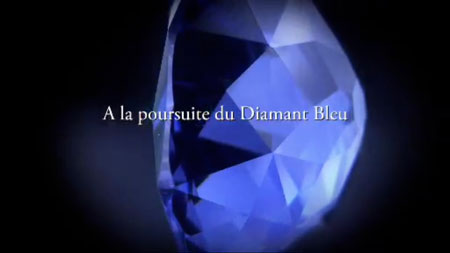 |
| Tracking the Blue Diamond. Click here for the preview of the documentary. |
Dr. Farges and “la saga du diamant bleu” were covered on television’s TF1, the most popular in France, on October 31. See the segment here, and look for Dr. Jeffrey Post. [back to top]
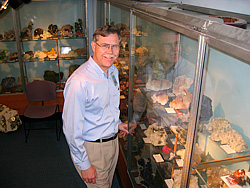 |
On October 22, the Jewelry Information Center (JIC, consumer education arm of Jewelers of America) announced that its GEM Award for Lifetime Achievement will be presented to Dr. Jeffrey E. Post, curator of the U.S. National Gem and Mineral Collection at the Smithsonian’s National Museum of Natural History.
The award will be presented on January 7, 2011, at Cipriani 42nd Street in New York, along with other awards honoring industry notables. The Lifetime Achievement Award “is granted selectively to those who have built a career’s worth of notable contributions to the fine jewelry and watch industry,” according to a JIC press release, which continued:
Jeffrey E. Post’s contributions are consummate. Prior to joining the Department of Mineral Sciences at the Smithsonian Institution in 1984, Dr. Post was a Postdoctoral Research Fellow in the Department of Geological Sciences at Harvard University. From 1989 to 1994, he was Chairman of the Department of Mineral Sciences and, since 1991, has served as Curator of the U.S. National Gem and Mineral Collection. Dr. Post served as the lead Curator for the Janet Annenberg Hooker Hall of Geology, Gems and Minerals that opened in 1997. His areas of research interest include mineralogy, gemology, geochemistry, crystallography and electron microscopy.
Dr. Post appeared in our pages in September, in our notice of Gary Roskin’s coverage of an exceptional opportunity sponsored by the Smithsonian for access to the Hope and Wittelsbach-Graff diamonds. [back to top]
Oh, those wacky museum curators. When they’re not appearing on television, receiving awards, or hosting hands-on sessions for some of the most famous gemstones in the world, they’re off to rub shoulders with the jaderos (jade researchers) of Guatemala in the Motagua Valley…
But let’s be serious. Dr. George Harlow, curator of gems and minerals at the American Museum of Natural History, has posted a two-part overview of his trip this month with a team of geologists to research the origins of jade, which is a surviving legacy of prehistoric Mayan artistry.
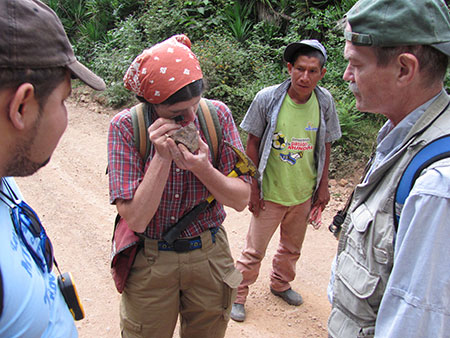 |
| Got green? Kennet Flores (Post-Doctoral Fellow at AMNH), Jinny Sisson (University of Houston), a local Chorti, and George Harlow checking out rocks near Camotán in Guatemala. (Photo: Jamie Newman, courtesy of the American Museum of Natural History) |
In these posts, Dr. Harlow discusses the origins of the Caribbean region and its “theme of green rocks” that includes jadeite and serpentinite. By the good fortune of a shortcut, the group saves time and effort in successfully pursuing their green goal. Read “On the Trail of Green Rocks” and “In Search of a Jade Host Rock,” at the blog Scientist at Work, a electronic field journal crafted by Stuart Sandin, associate professor at Scripps Institution of Oceanography’s Center for Marine Biodiversity and Conservation, hosted by The New York Times. [back to top]
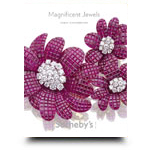 |
View video of Sotheby’s David Bennett as he discusses a 24.78-carat fancy intense pink emerald-cut diamond that set a record on Tuesday. According to pre-sale publicity, the Gemological Institute of America has stated that the gem may be “potentially flawless” once it is repolished.
Lawrence Graff was the lucky buyer, bidding nearly 7.5 million Swiss francs above the expected sale price. The $45.75 million hammer price almost doubled the previous record for any jewel at auction. And what might that previous record-setter be? The Wittlesbach blue, to which Mr. Graff appended his name. He’s calling this one “The Graff Pink,” according to Rapaport, and called it the “most fabulous” diamond he’s seen in his nearly 60-year career.
The post-sale press release is available here. The online catalog entry for Lot 550 is available here. [back to top]
Earlier this month, we sent our subscribers a news flash regarding new findings on the muddled subject of andesine from Tibet. An international expedition a month ago organized by Ahmadjan Abduriyim (Gemmological Association of All Japan–Zenhokyo) determined red andesine to be the real thing—at least at one locality visited, Zha Lin. The groups was denied access to Bainang, which Abduriyim had visited before, and a visit to Yu Lin Gu was inconclusive. See the news flash here.
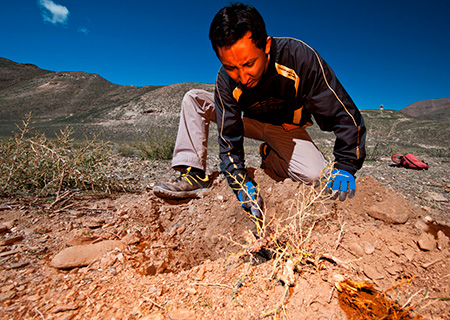 |
| Ahmadjan Abduriyim carefully excavating beneath a bush in lower Yu Lin Gu valley, near Zha Lin village in Tibet's andesine mining district. (Photo: Richard W. Hughes, from his article on Ruby-Sapphire.com) |
Just before publication of the four post-expedition reports (accessible at the link above), Dr. Adolf Peretti (GemResearch Swisslab), along with three researchers from Zurich’s Laboratory of Inorganic Chemistry, published a study titled “Authenticity and provenance studies of copper-bearing andesines using Cu isotope ratios and element analysis by fs-LA-MC-ICPMS and ns-LA-ICPMS,” in the journal Analytical and Bioanalytical Chemistry.
According to this article, Dr. Peretti visited a locality near Gyaca in Tibet a year ago, facilitated by the same mine owner used by Abduriyim in 2008; Abduriyim visited Bainang, about 450 km. to the west. Peretti’s visit convinced him that the site had been salted. “Hundreds of copper-andesine specimens were found, but only occurred in disturbed spots and a single grain size layer. Undisturbed layers with fine sedimentary structures of other grain sizes featured no copper–andesine specimens.” Dr. Peretti even observed miners “positioning samples into different spots.” Nevertheless, he tested the material alongside material gathered by Abduriyim at Bainang in the fall of 2008, as well as a variety of ten other samples purported to have come from localities worldwide.
Both the above-referenced Tibetan samples, perhaps not surprisingly, were determined by Peretti’s study to be treated. And out of all twelve samples, “the only irrevocably naturally colored mineral” was from Oregon.
More research is needed, of course. The article closes with a reference to the more recent expedition organized by Abduriyim, and an acknowledgment that material from that expedition was not available for the study by Peretti et al. [back to top]
Burma’s annual fall “Mid-Year” gem emporium, traditionally scheduled for October (as announced in a September Myanmar Times article) has been postponed. A September 15 story in The Irrawaddy, quoting an official, stated that the construction of exhibition facilities and hotel rooms for an estimated 7,000 foreign traders was not yet complete. The October sale was to be the first held in the country’s administrative capital of Nay Pyi Taw.
 |
| STOP! This traffic-signal-red 2.54-carat spinel from Burma seems unnaturally glorious. But it’s not… Inventory #18721. (Photo: Mia Dixon) |
A new event venue, Maniyadana Hall, was being built adjacent to the gems museum. Eleven Media Group (EMG) reported in an undated story (picked up by the Chinese Xinhua News Agency on October 22) that the hall will host the emporium November 17–29, according to a Myanma Gems Enterprise official.
The new venue and emporium has sparked a rent boom, according to a November 15 Myanmar Times story.
The EMG story states that “some 10,000 lots of jade” will be offered at the emporium. The Xinhua story states that over 600 tons of jade from Phakant, Kachin state, will be displayed.
The Xinhua report also notes a remarkable statistic for the first four months of Burma’s 2010–11 fiscal year, April through July. Nearly as much jade was produced in that single trimester as in the entire 2009–10 fiscal year.
This four-month output is one million kilos more than for each of the 2006–07 and 2007–08 fiscal years.
Current production of ruby, sapphire, spinel, and peridot seems to be in line with the previous fiscal year, based on figures released in early September by Burma’s Central Statistical Organization.
Last July, we referred to a web page containing an $800 million figure for Burma’s June–July 2010 sale, attributed to Xinhua, but a search of Xinhua’s own pages turned up nothing. But on August 18, Rapaport’s Diamonds.net quoted Xinhua, and put the figure at $885.5 million (€700 million), from the sale of 7,000 lots of jade and gems. We have added this number to the running total of all reported sales figures on our Burma Gem Sales and Statistics.
Last December we noted that Yangon’s Kandawgyi Palace Hotel would feature 60 showrooms devoted to a permanent exhibition of gemstones. Last month, the hotel was sold to buyer Htoo Trading, owned by tycoon Tay Za.
According to a page on its website (currently under construction), the hotel’s Jewelry Trade Center Yangon consisted of “over 120 small and medium sized traders….” The new owner notified these traders on October 6 that they were to move out “by November,” as reported by The Irrawaddy. Htoo Trading will retain a “training school” at the hotel, which was mentioned in last December’s report.
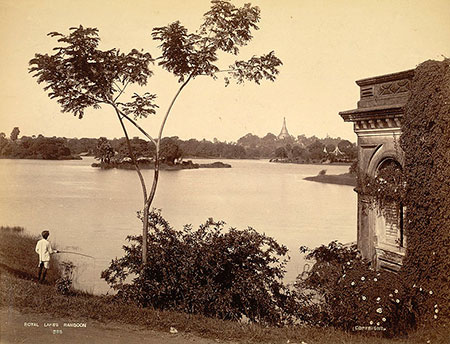 |
| Kandawgyi Lake. The Kandawgyi Palace Hotel now occupies an area to the east of the Shwedagon Pagoda, which dominates the skyline of this 1895 photograph taken in 1895, when Burma was a province of British India. (Photo: Philip Adolphe Klier; Fowler&fowler, Wikipedia) |
There is speculation that the buyer also may purchase the Strand and Traders Hotels, in anticipation of a post-election tourism increase, according to Deutsche Presse-Agentur.
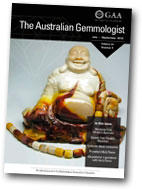 |
The July–September 2010 Australian Gemmologist includes an article discussing gem-quality spinels found in alluvial deposits in southeast Burma’s Kayah State, written by U Tin Hlaing, Wilawan Atichat, Chakkaphan Sutthirat
Microscopic observations reveal healed fractures to be commonly present. Chemical analysis shows the material to be almost pure spinel.
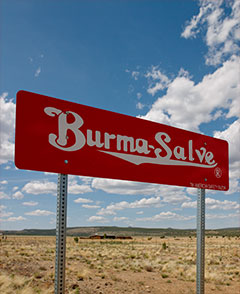 |
On the weekend of Burma’s historic November 7 election, The Myanmar Times included a take on the situation by Dr. Tin Aung Shwe, a non-aligned candidate in Yangon’s Pabedan Township. He had no illusion that a dramatic change would occur via the polling, stating that it “will not complete the process of change,” but will be the beginning of a move forward.
Aung San Suu Kyi, now freed from house arrest, called for reconciliation in her first appearance Sunday. But her remarks also addressed sanctions against her country. “If people really want sanctions to be lifted, I will consider this,” she was quoted by Reuters. “This is the time Burma needs help. We ask everyone to help us. Western nations. Eastern nations. The whole world...it all starts with dialogue.” Having supported sanctions in the past, Suu Kyi is perhaps the ideal figure to negotiate their end and begin re-engagement with Europe and the U.S. [back to top]
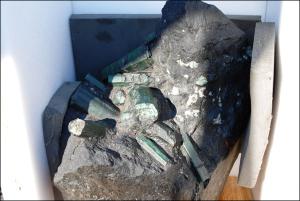 |
Last Wednesday a judge heard testimony from a Northern California businessman who claimed he is the rightful owner of the 840-lb. “Bahia” Emerald, having purchased the rock for $60,000 from the same Brazilian miners who sold him the 50-lb. emerald that he still owns, and which bears his name. Anthony Thomas testified that he believed the large rock’s true value was discovered and he was told it had been stolen prior to shipment. While claiming the bill of sale was burned in a house fire, Thomas presented two dozen photographs from 2001 of himself with the stone in Brazil.
Thomas also claimed that a former friend, Ken Conetto, in the process of facilitating the sale, had conspired with the miners. Conetto had himself claimed the stone for his own, and has settled that score with other claimants. Other details from last week’s trial are found in November 10 stories by Associated Press and The Gilroy Dispatch.
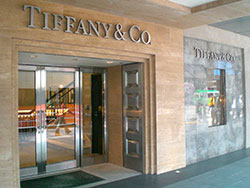 |
| Central Landmark Mall, Hong Kong. (Photo courtesy Wikipedia) |
China Daily reported on November 2 that China is set to become the “jewel in the crown” of Tiffany & Co. The jeweler plans to place more new locations in that country than anywhere else globally, with a projected number standing at 25 or 30, according to Tiffany chairman Michael J. Kowalski. Fourteen stores alone in the Feb 2010–Jan 2011 fiscal year are projected. Tiffany took the unprecedented step of debuting a major collection outside its home market—in Beijing on October 22—in recognition of China overtaking the U.S. as the largest jewelry market in five to ten years. Yellow diamonds are on the horizon next year for the jeweler’s designs.
An October 20 sale at Christie’s New York set a per-carat record with the sale of a 10.95-carat fancy vivid blue diamond, the posh partner in a two-diamond ring that went for nearly $16 million. The triangular-shaped blue was the largest of its kind and cut ever to be offered at auction, according to a post-sale release.
 |
A “potentially flawless” pink for the pinkie too plush for the plasma? How about a diamond doll with a petite 1-ct. pink? When designer Stefano Canturi was invited by Mattel to create a one-of-a-kind couture for its icon, he chose an Australian Argyle centerpiece pink for a choker-and-ring combo in the spirit of his signature “Cubism” line. After leaving Ken, Skipper, and Midge for a solo 40-day world tour, Babs was bagged for $300K-and-change in a Gotham auction benefiting The Breast Cancer Research Foundation. See the videos here and the story at BBC. [back to top]
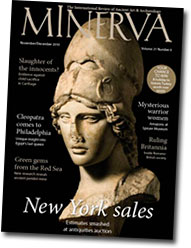 |
St. John’s Island or Zabargad, the Arabic word for peridot, is purportedly the world’s oldest known source of gem olivine. Situated in the Red Sea about 45 km. southeast of Ras Banas on the coast of Egypt, much has been written about Zabargad’s unusual geology and modern workings; however, unequivocal evidence of an ancient mine has not been reported until now. In an article appearing in the November/December issue of MINERVA magazine (“Egypt’s Evening Emeralds,” pp. 16–19), James Harrell (University of Toledo, USA) and Elizabeth Bloxam (Monash University, Australia) provide the first description of the ancient mine.
Ancient writers identified Zabargad as Ophiodes (Snaky) and also Topazos, and they called the yellowish green transparent gem found there topazos. Peridot appears to have been used sparingly in the Mediterranean cultures of the Hellenistic and Imperial Roman periods. Extant examples are primarily intaglios or plain, unengraved ringstones and their dates of manufacture range between 250 BCE and 500 CE.
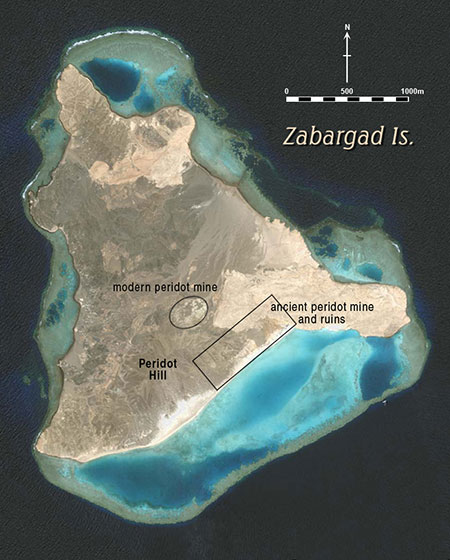 |
| Satellite map of Zabargad Island, Egypt, above. Gem quality peridot specimens, below (click to enlarge), from modern and ancient mines on Zabargad Island, collected by James Harrell, 2010; cabochon (12.7 x 9.9 x 3.9 mm.) from modern mine purchased in Cairo market in 2009. (Photo: Lisbet Thoresen) |
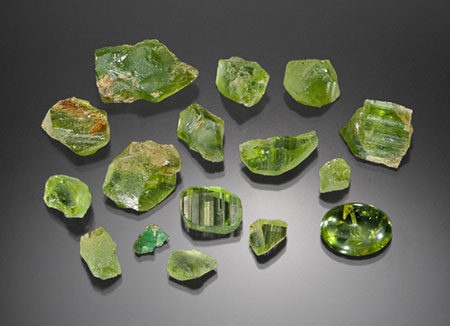 |
Commercial peridot and garnierite mining occurred on Zabargad Island during the first half of the 20th century, but since then the island has been abandoned except for the occasional temporary military camp. The ancient mine is located on the island’s southeast shore and consists of roughly 150 surface pits, which individually are up to 20 meters across with adjacent spoil piles as high as 5 meters. Peridot crystal fragments up to 1.5 cm. across are commonly found on the surface within these workings. The modern mine reportedly yielded whole crystals up to 20 cm. in length, and crystal fragments nearly as large as this were observed by the authors. Similarly large peridot crystals undoubtedly came from the ancient mine, as well.
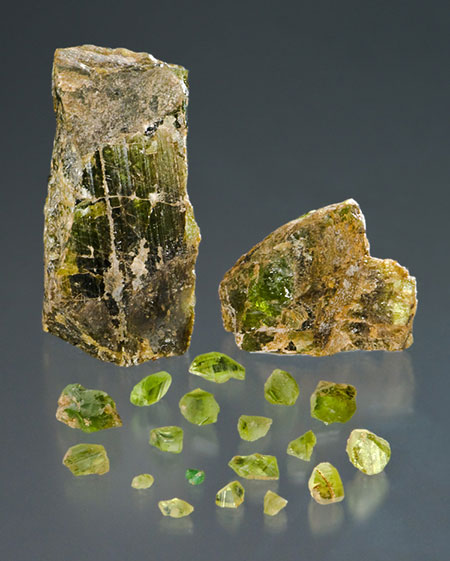 |
| Specimens of gem quality peridot (click to enlarge) from the ancient mining site on Zabargad Island. Collected by James Harrell, June 2010. (Photo: Lisbet Thoresen) |
Also associated with the mine are the ruins of stone dwellings, which housed the miners, and a well that provided them with water. Pottery fragments, which are especially common around the well, date mainly from the 3rd to 1st centuries BCE of the Hellenistic period with the rest extending into the Roman period. The miners and their supplies would have come from the Graeco-Roman port city of Berenike, on the Egyptian mainland 80 km. northwest of Zabargad Island. Mining activity on Zabargad probably closely mirrored the rise and fall of Berenike’s fortunes, which peaked in the 1st century CE, and when this city was abandoned by the mid-6th century CE, so also was the peridot mine on Zabargad Island.
Thank you to Drs. Harrell and Bloxam, and also to Lisbet Thoresen for facilitating this news item. [back to top]
For some time now, Joseph O. Gill has offered Gill's Historical Index To Gems And Jewelry in an online edition—free of charge. Last month he notified us of an update to the index as of August 13, 2009. The index includes 20,000 listings of publications in English on gems and jewelry, from 1652 until 2009.
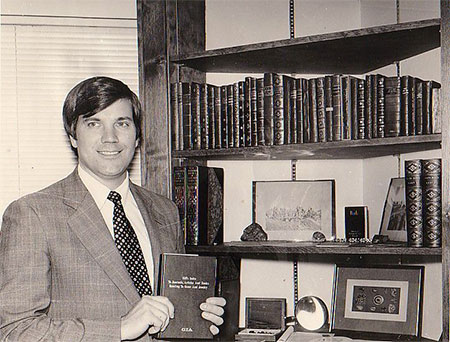 |
| Joseph O. Gill with an early copy of his index. (Photo courtesy Joseph O. Gill) |
See also these other digital resources by Gill:
And see our February 2009 profile of Gill and his work. [back to top]
Something from our sister e-newsletter, Pala Mineralis…
In the second issue of our fledgling mineral newsletter, back in 2006, we looked at the RRUFF™ Project, a website that provides users with integrated data on Raman spectra, X-ray diffraction, and chemistry for minerals—terrestrial and extraterrestrial.
Today, the add-ons now available to users make this a very versatile resource. We brought readers up to date last month on Palaminerals.com.
What we didn’t point out, however, was the Software Development page on the project website. CrystalSleuth, a Windows-based application, can analyze both Raman and powder diffraction data sets. It’s able to compare the user’s Raman pattern against the RRUFF™ Project database. The software allows manipulation and refinement.
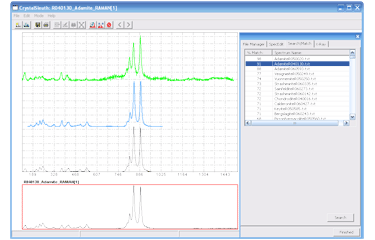 |
| CrystalSleuth can search a user supplied Raman pattern against the RRUFF™ Project database. (Click to enlarge) |
[back to top]
— End November Newsletter • Published 11/17/10 —
Today, three remarkable reports regarding Tibetan andesine were posted online by Richard W. Hughes on Ruby-Sapphire.com, by Ahmadjan Abduriyim (Gemmological Association of All Japan–Zenhokyo) and Brendan M. Laurs (Editor, Gems & Gemology) on the Gemological Institute of America’s GIA.edu, and by Thanong Leelawatanasuk (Gem and Jewelry Institute of Thailand) on GIT.or.th. Following a Tibetan locality visit by an international team a month ago, the reports demonstrate that andesine collected from the locality is… Well, you’ll have to read them for yourselves.
The following were published subsequent to our November 3 News Flash.
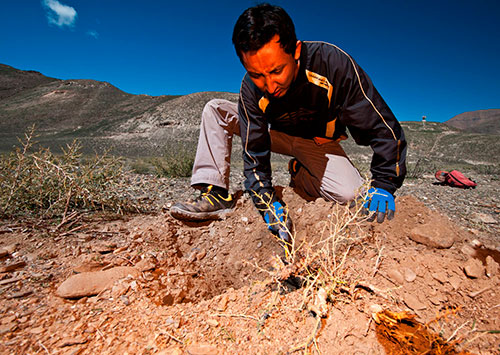 |
| Ahmadjan Abduriyim carefully excavating beneath a bush in lower Yu Lin Gu valley, near Zha Lin village in Tibet's andesine mining district. (Photo: Richard W. Hughes, from his article on Ruby-Sapphire.com) |
In this issue, we have a trick-or-treat bag full of goodies, from our shape-shifting featured stone to an agate in agony, scary fillings and scary stories. Enjoy…
Okay, we had some fun last month with the stunning specimen pictured below, shown in a different context, but we neglected to obtain the name of the photographer—Jeffrey Scovil—for which we apologize. The image was posted on the Munich show website but due to a database failure the ID was missing. So we asked you to name that mineral.
The specimen is elbaite (a species of tourmaline), named after Italy’s island of Elba, where it was discovered in 1913. Five out of six respondents correctly answered with variations on tourmaline, including indicolite and verdelite. One other respondent guessed epidote. In any case, you’re all winners—and here’s where we had the fun—because you’re already subscribed to Palagems Reflective Index. It’s the name of this newsletter.
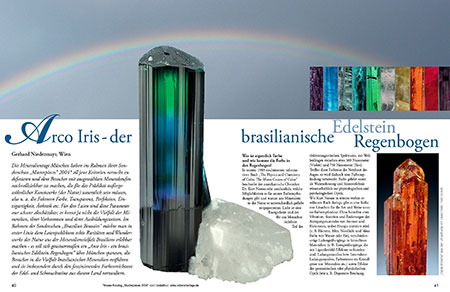 |
| From the show catalog. The center photo by Jeffrey Scovil portrays a Brazilian elbaite from the collection of Marcus Budil. At the right is an imperial topaz from Ouro Preto in Brazil’s state of Minas Gerais, also photographed by Scovil. Grab your Deutsch-Englisch dictionary and Click here for a 6.4MB PDF of these pages. |
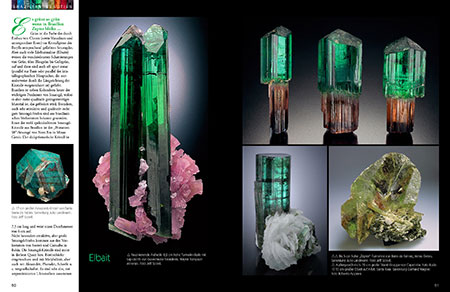 |
This year’s special exhibit is titled “Arco Iris: the Brazilian Gemstone-Rainbow over Munich.” The show website describes it like this: “The seven color wonders of the rainbow-collection will make the visitors quite literally walk on air. An exclusive show that has never been seen before!”
This year’s show also features “Mont Blanc: Crystal Treasures from Europe’s Rooftop” as the alpine highlight, and will include red fluorites. The region takes its name from western Europe’s highest mountain and is home to the famous Chamonix—so famous that collectors must obtain a permit from the mayor’s office. To the south is Italy’s Aosta Valley, with dozens of localities, many of which will be represented. The larger alpine exhibit, of which this is the centerpiece, will include emeralds from Habachtal and treasures from Traversella, in addition to the Alps’ largest gold and mineral finds.
The Munich show’s jewelry studio features designers and goldsmiths who will create something on the spot, individualized, with no obligation. If you like it, commission it and it’s yours.
Pala International’s Bill Larson and Will Larson will attend this major gem and mineral show…
For more information visit the show website. See the Pala International Show Schedule for future events.
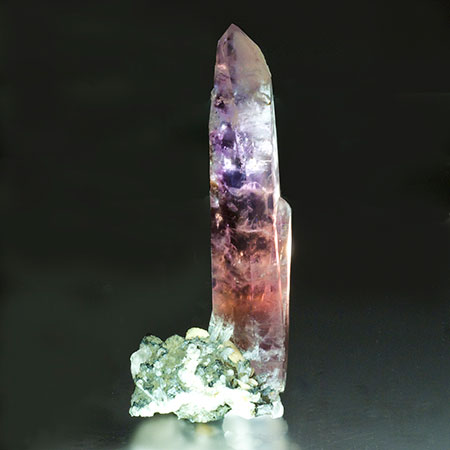 |
| This amethyst from Piedmont, Italy, from the collection of Pala’s Bill Larson, will be displayed in Munich as part of an exhibit of Traversella specimens. It measures 15 x 6.5 cm. (15 x 3.5 cm. crystal alone). (Photo: Mia Dixon) |
The specimen pictured above, Bill Larson tells us, “I obtained from Alfredo Ferri of Milan in 1972. It was said to be from the famous Italian Magistretti collection. I sold it to the late F. John Barlow, who kept it for 20 years before exchanging it back to me as a favor.” [back to top]
This month we feature a cuprite that is not usually on the palette for gem collectors. In fact, it’s rarely seen in fine faceted gems such as this 46.07-carat beauty. Fairly common to the mineral world, cuprite rarely crosses over to the gem trade in fine material, and the rough has become increasingly harder to obtain.
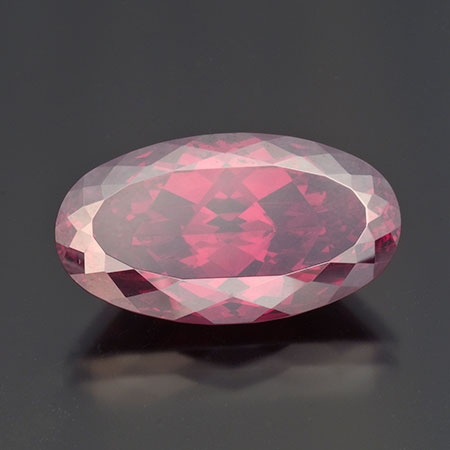 |
| Cuprite from Namibia, 46.07 carats, elongated oval 25.61 x 14.2 x 9.8 mm. Inventory #18563. (Photos: Mia Dixon) |
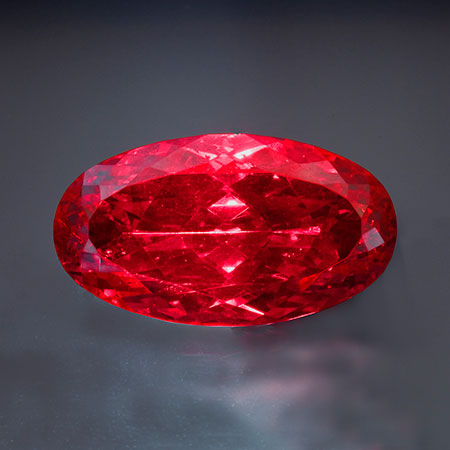 |
Consisting of just copper and oxygen, cuprite is associated with native copper, malachite, and azurite, and is found in oxidation zones of copper deposits all around the world. This gem is from the Emke Mine, Ogonja (Onganja), Windhoek District, Khomas Region, of Namibia. Its dark initial metallic luster is deceiving, because when the lights shine through, a ruby-red gem illuminates.
See a natural cuprite crystal here. And see the Mindat.org entry for cuprite.
Interested? Select the inventory number above, call, or email us to inquire. [back to top]
Will Larson will speak at the November 11 general membership of the Fallbrook Gem and Mineral Society. His subject of his presentation will be gem and mineral mining projects that he has worked on, past and present.
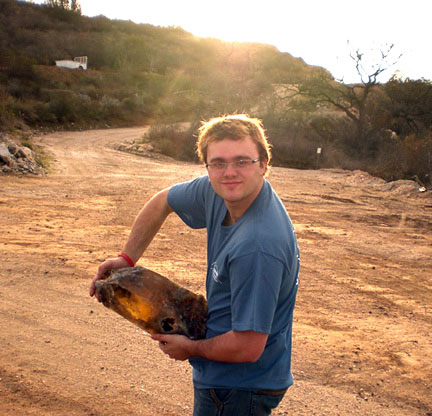 |
| Will Larson showing off a large citrine crystal at a visit to the Oceanview Mine in the Pala Mining District, December 2007, which yielded facetable grade material. (Photo: Bill Larson) |
The meeting will be held from 7:00 to 9:00 p.m. at the Society meeting hall, 123 W. Alvarado Street. Contact information is available from the Society website. [back to top]
Gemologist, author, and collector Alan Hodgkinson wrote us last year, a little too late for us to run this photograph of an agate in his collection. “I thought you might like to see how nature can vie with the artist,” he said, “if you think of Edvard Munch’s The Scream. This agate from my collection produces a much higher decibel scream.” Click the photo to get the full force.
[back to top]
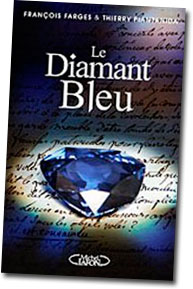 |
In nine days, a new historical novel, Le Diamant Bleu (yes, that blue diamond) will be released. The writer is someone who should know his way around the subject—Dr. François Farges, professor of mineralogy and curator of minerals at Paris’s Muséum National d’Histoire Naturelle. He last was featured in our pages regarding the recreation of Louis XV’s insignia of the Order of the Golden Fleece, a major element of which was The French Blue, the 69-carat predecessor to the Hope Diamond. (It is the former stone’s replica, fashioned from cubic zirconia, that graces the book jacket.)
Farges, who co-authored the book with Thierry Piantanida, told us that he has incorporated the discoveries made in 2007 into the novel, so it will conform strictly with the facts as they are known.
The 300-page novel, published by Michel Lafon in French, is available for pre-ordering on websites such as Amazon.com.
From the written word to the big screen. You’ll want to look for Dr. Farges’s cameo appearance (in a canoe) in an extract from the film Tracking the Blue Diamond, for which co-author Piantanida served as co-director and co-writer. A 52-minute version of prospective 90-minute final cut was screened in Paris to an enthusiastic audience a week ago Sunday as part of Pariscience International Science Film Festival. The film, co-directed by documentarian Stéphane Bégoin, is a joint production of GEDEON Programmes, ARTE France, and National Geographic US.
| See the extract from Tracking the Blue Diamond. |
Gary Roskin has parted the veil on the second installment of “An Evening with the Blues: The Hope and Wittelsbach-Graff Diamonds.” In this segment he explains who’s who, who was there, and why, on a January evening at Washington D.C.’s National Museum of Natural History. [back to top]
Richard W. Hughes and Vincent Pardieu have been wanderers of the globe together for years. Vincent credits Richard’s Ruby & Sapphire with sparking his interest in gemology, and changing his life—“for the best!” Well, the wanderlust has taken hold again, but this time on the part of Hughes, semi-solo—his beloved wife, Wimon Manorotkul at his side—from Bangkok where he’s been for the past few years, to Hong Kong. In “A friend on the road again,” Vincent discusses Richard’s departure to work with Sino Resources Mining Corporation, which bills itself as “a leading conservation gem miner.”
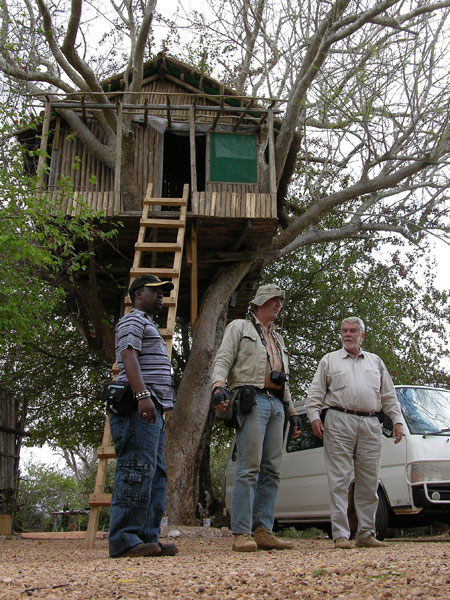 |
| That was then… The late Campbell Bridges, the discoverer of the grossular that would be known as Tsavorite, stands at right before his tree-top house in the Tsavo area, with Pardieu, center, and Kennedy Khamwathi. (Photo: Jean Baptiste Senoble, 2005, courtesy Vincent Pardieu) |
Africa has called Vincent and Richard a few times, to the tanzanite mines of Merelani, the corundum boomtowns of Madagascar, and the tsavorite mines of southeastern Kenya.
Tsavorite, the green variety of grossular garnet, was discovered in Tanzania in 1967. An analysis of the material appeared as early as 1974 and 1979 in Gems and Gemology (see this bibliography at the RRUFF™ Project; scroll down). But not until this month, 43 years later, has a thorough study of the original tsavorite mining district been done. Julien Feneyrol, with the support of Vincent Pardieu and some French and Tanzanian geologists, look at the subject in “Lithostratigraphic and structural controls of ‘tsavorite’ deposits at Lemshuku, Merelani area, Tanzania,” published in Comptes Rendus Geoscience, the journal of the prestigious Académie des Sciences, which was founded three centuries (almost to the year) prior to the discovery at Lemshuku.
The bull of the dispute
is driven up the walls.
—Federico García Lorca, “Reyerta” (“The Dispute”)
Between jobs, Richard Hughes has reworked his website, Ruby-Sapphire.com, for your browsing pleasure. “The Black Prince’s Ruby: Blood-red souvenir of conquest” is a stand-alone reworking of Hughes’s essay on the famous “ruby” included in the author’s Ruby & Sapphire.
A large red spinel octahedron made its debut on the public stage in the days of the mid-14th century, when kings would negotiate deals like drug lords, on the edge of a saber. Such a ruler was Pedro el Cruel, king of much of the Iberian peninsula, who seized the jewel from one of two rivaling sultans of nearby Granada. The unlucky rival, Mohammed VI (aka Abu Said), was lured to Seville by Pedro, who murdered him, took his treasure (including the spinel), and sent his severed head to Mohammed V, who would put the finishing touches that he’d learned in exile on the Alhambra, the red fortress. The year was 1366; by 1367 the red jewel would be turned over as tribute to Edward, The Black Prince, whence comes the name Black Prince’s Ruby. In 1369, Pedro himself was lured into a trap hatched by his half-brother Enrique de Trastámara, and beheaded.
 |
| Edward of Woodstock, The Black Prince. From Cassell’s History of England – Century Edition (1902). |
Today, the Black Prince’s Ruby is mounted as the centerpiece of the Britain’s Imperial State Crown. But it might not have been. You’ll want to read why.
And you’ll want to read “Buying at the Source,” in which Hughes crafts a cautionary tale from experiences personal and otherwise for those “many tender blossoms, newly initiated into the gem trade.” He then distills that wisdom into a theorem (complete with mathematical formulae!). And if we needed more proof, that proof is offered.
Hughes loves mining the literature almost as much as exploring the mines. He follows up Dick’s Law with a selection from The Pearl Trader, by Louis Kornitzer, a prominent British gem dealer of the early 20th century, in which the narrator learns a lesson. [back to top]
 |
Gemology and mineralogy online forums have been talking about 405-nm (nanometer) laser pointers and their application in identification of gems and minerals. In 2009, these inexpensive tools created a buzz on the MailTalk newsgroup of The Gemmological Association of Great Britain (Gem-A). In an article titled “Pointers for identification,” in Gem-A’s Gems & Jewellery this summer, German gemologist Michael Seubert uses the pointer to sort out synthetic HPHT diamond from the real thing.
Gemologists will be familiar with the use of ultraviolet (UV) light to help identify gemstones, via the form of luminescence known as fluorescence. Richard W. Hughes, in his Ruby & Sapphire (p. 75) writes, succinctly, that fluorescence “results when a stone absorbs higher energy (visible light, ultraviolet light or x-rays), and then re-emits it as lower energy in the visible region.”
The 405-nm beam is very close to the non-visible UV spectrum of 10 to 400 nm. When directed at gemstone material this beam can help identify the material, as this chart from The Gemology Project suggests. Hughes, however, on pp. 76–77, explains that fluorescence
usually is caused by impurities within the stone, with only tiny fractions of one percent being necessary in many cases. Since the impurity content can vary a great deal from stone to stone, the fluorescent reactions also may vary. Thus, fluorescence should never, never be solely relied upon to establish the identity of a gem.
Interestingly, Hughes includes a diagram on p. 79, by way of geophysicist Dr. Don Hoover, which shows that, in the case of ruby, substantial fluorescence is generated in a very large range of light in the visible region—from 400 nm to the diagram’s endpoint of 600 nm.
Everyone should know by now also that laser pointers can cause serious eye damage from the direct beam. But the laser’s beam also can be reflected back with enough energy to cause concern. UV cabinets likely include protective spectacles, but laser pointers don’t, of course. A post in the GemologyOnline thread points to such protective wear.
 |
But should you care, if you already have a hand-held UV light? Dr. Hoover’s colleague, gemologist Bear Williams of Stone Group Laboratories, explains why you should indeed, in a 2007 article published in The Guide. While laser beams are extremely concentrated in their specific wavelength output, the older mercury tube UV bulbs actually emit broader ranges, and other longer wavelengths outside their specs. This can be problematic. “Since other energy is present, which energy is truly activating the fluorescence of a particular stone?” Williams asks. The graph on page one of the article clearly shows a 365-nm bulb spiking where expected—and where not expected, at 404 and 435. Results simply can’t compare with those obtained via a pure 365-nm source.
Williams then takes a look at commonly available LED light sources, in the range of 392 to 645 nm. Looking at a graph produced by the five LEDs, he asks, “Is there bleed or extraneous illumination caused by LEDs?” And answers, “No, each produces a singular, pure light range.” He then predicts that these tools will become commonplace in the lab, and could lead to a kind of standardization.
The rest of the article is peppered with some intriguing surprises. We are grateful to Bear Williams for his input on this subject. Visit StoneGroupLabs.com for more published information. [back to top]
Not another take on lead glass, you’re thinking. Well, yes. But this time we point to a case study—from the jeweler’s point of view—of unwitting “damage” done on the bench due to lack of treatment disclosure. And a look at the issue of disclosure, from the point of view of a gemologist-journalist.
Last month, jeweler Wink Jones posted an account on PriceScope of receiving a call from a client who claimed her stone had been ruined during setting. The only thing Jones really remembered about the stone was its unattractive appearance. The client complained that the stone was now scratched, and so Jones spent a few days in a stew while the stone was being returned to him, wondering what could have gone wrong.
In Jones’s words, “worry turned to disgust” after he received the returned stone, but perhaps with a certain amount of relief when he realized the cause. The stone’s many inclusions were no longer filled where they reached the surface: the “scratches.” Simple cleaning after setting had done this so easily, Jones originally thought the filler must have been wax. He took a series of photos and sent them to the client, who forwarded them to the original seller, who was embarrassed and offered a replacement.
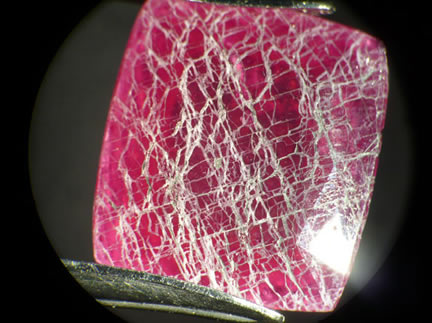 |
| Not wax. Damage to glass filling during resizing. Heating lead glass-filled stones can result in exposure to the Pb on the part of the jeweler. (Photo: Lore Kiefert, courtesy AGTA-GTC, January 2008) |
The treatment turned out not to be wax, but rather, lead glass. Jones had learned about it at the Vegas show; it just took a while for the material to move from the market to his bench. (That may say something about the quality of the stones that pass through his doors.) Jones has begun taking before-and-after photos of the stones on which he works. Not a bad idea. Jones’s client and the client’s dealer were understanding, but some might not be. As Jones points out, clients could demand satisfaction from the independent jeweler who “ruined” the jewel during routine work.
A: When it “does not possess the beauty, symmetry, rarity, and value necessary for qualification as a gem.” This statement, from a Federal Trade Commission regulation, is included in Gary Roskin’s detailed discussion of glass-filled ruby, “Weighing in on the $6 Ruby.”
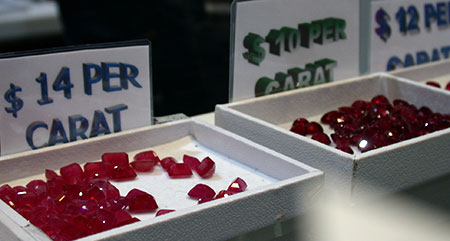 |
| Recession reaction? Not hardly. At these prices, from the Las Vegas Antique Jewelry & Watch Show, you’d spend more on the setting than the stone. But you might want to mention that fact to your jeweler… (Photo: Gary Roskin) |
It’s convenient when you have the feds telling you what to do. You have to disclose that
But the way to accomplish that disclosure without raising sale-killing red flags is the challenge at the heart of Roskin’s article. At the time Roskin was preparing his piece, we actually were in the process of tackling the same subject, but found the variance in descriptions and disclosure terminology to be thorny enough to send us back to do some benchwarming. [back to top]
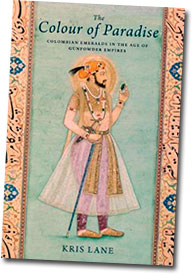 |
Earlier this month, in our sister e-blast, Pala Mineralis, we looked at a variety of verdant vagaries and such, down the emerald aisle.
Another story for the viridescent devotee appeared last month in the New York Times. “Jade From China’s West Surpasses Gold in Value” discusses the happier plight of the maligned Uighurs of Khotan, the historic oasis town that was a landmark on the Silk Road.
And, finally, if you haven’t read it yet, see Richard Hughes’s “The Emerald Buddha, symbol of the Kingdom of Thailand.” [back to top]
— End October Newsletter • Published 10/19/10 —
In this issue, again we are struck by the great fortune we have to revel in the reflection of Fine Creations From Planet Earth: our featured suite of demantoid garnets and their alexandrite compatriots, the two amazing “blues,” the glory of Gübelin. And yet we must contemplate the Exquisite Destruction By Planet Earth (and our hand in it). Would that we might take a portion of inspiration received by the former and put it to the service of those devastated by the latter.
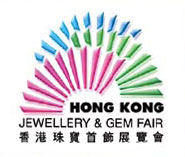 |
Pala’s Gabrièl Mattice is attending this fall’s largest international jewelry fair in Asia. This year’s show continues “a clear product sectorisation” between the two venues, according to the event website:
A press release states that this year’s fair five percent larger than last year: 3,205 exhibitors from 45 countries, with 40,000 buyers. [back to top]
Pala International’s Bill Larson and Will Larson will attend this major gem and mineral show…
This year’s special exhibit is titled “Arco Iris: the Brazilian Gemstone-Rainbow over Munich.” The show website describes it like this: “The seven color wonders of the rainbow-collection will make the visitors quite literally walk on air. An exclusive show that has never been seen before!”
 |
| Elbaite from the collection of Marcus Budil, photographed by Jeffrey Scovil. |
This year’s show also features “Mont Blanc: Crystal Treasures from Europe’s Rooftop” as the alpine highlight, and will include red fluorites. The region takes its name from western Europe’s highest mountain and is home to the famous Chamonix—so famous that collectors must obtain a permit from the mayor’s office. To the south is Italy’s Aosta Valley, with dozens of localities, many of which will be represented. The larger alpine exhibit, of which this is the centerpiece, will include emeralds from Habachtal and treasures from Traversella, in addition to the Alps’ largest gold and mineral finds.
The Munich show’s jewelry studio features designers and goldsmiths who will create something on the spot, individualized, with no obligation. If you like it, commission it and it’s yours.
For more information visit the show website. See the Pala International Show Schedule for future events. [back to top]
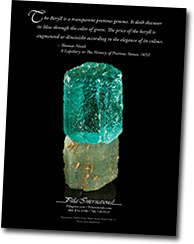 |
| See our ad in this year’s program. |
[back to top]
 |
“Advancing the Science and Business of Gems” is the theme of the 2011 symposium. With this event, the Gemological Institute of America (GIA) celebrates its 80th anniversary. The symposium will be presented in two parallel tracks:
The event will also include a poster session. Pre-symposium offerings include hands-on workshops, a visit to the “All That Glitters” gem and jewelry exhibit at the San Diego Museum of Natural History, and field trips to local working gem mines. Registration will open Oct. 15, and capacity will be limited. Visit the symposium website for more details. [back to top]
This month we feature not only a rare and exceptional gem, but a whole line of dazzling green gems. Well matched and full of life, this exquisite line constitutes all the desired properties of demantoid garnet from Russia. The recognizable intense yellow-green hue, strong brilliance and dispersion, and of course the famed horsetail inclusions.
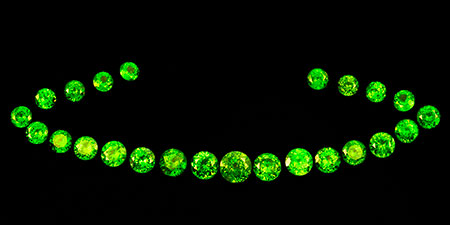 |
| Demantoid suite: 23 stones with a total weight of 15.73 carats, ranging from 5.9 to 4.4 mm. Inventory #18529. The center stone (Inventory #14850) is 1.72 carats at 6.74 mm. See enlargement here. (Photo: Mia Dixon) |
When we see horsetails we know they can be traced back to the Ural Mountains of Russia. There are limited quantities of demantoid starting to emerge again from Russia, but it seems new pricing has caught up to the extremely rare and beautiful nature of this gem. Luckily here at Pala we still have a good supply of older stock and thus can offer reasonable pricing consistent with a decade ago.
In the course of developing Palaminerals.com, we decided to apply some similar functionality to Palagems.com. First off, we’ve placed access to our Gem Search front-and-center on our Home page:
 |
Then, on our Gem Search page, we now are populating the dropdown menus for the following directly from the database (previously the menus were “hard-coded” with a standard set of terms):
For the time being, that means some duplication, until we’re able to make changes to our thousands of inventory items. But it means you now have enhanced access to every item in the Pala International database.
For instance, here’s a screenshot of the new Gem Type dropdown menu. Notice how Garnet - Transvaal Jade is duplicated as Garnet-Transvaal-Jade (no spaces) lower in the list? Until we make the fix, you’ll want to do a quick scan for duplicates, and be sure to search on all instances of a given gem type.
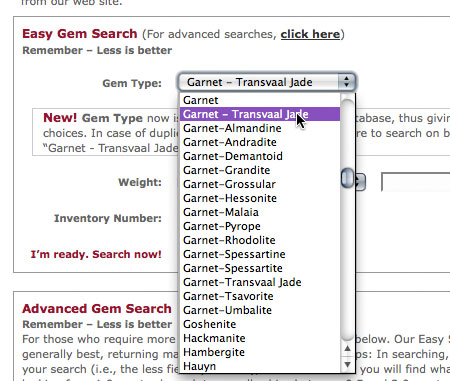 |
| Pictured here is the Gem Type menu for Easy Gem Search. It is populated in the same way as the Gem Type menu for Advanced Gem Search. |
Below is the new Shape/Cut dropdown, under Advanced Gem Search, displaying duplicates of Carved Free-Form, Cushion Cabochon, and Emerald. Eventually duplicates will be removed, but until then, “Use this selection with care,” as we have noted next to the menu. The same applies to Color.
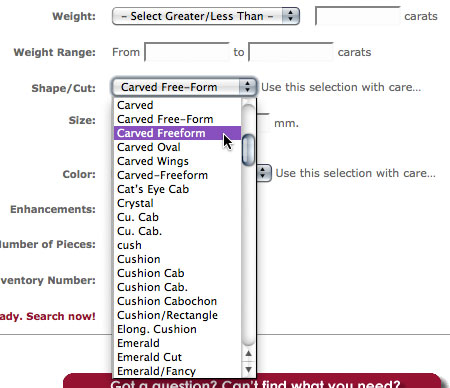 |
| Tip: Users likely will find the new menus to be most useful when using a single dropdown in combination with Weight Range, Size, and/or Enhancements. |
We thought it was important to give our clients enhanced access to the catalog now, rather than later, even though it requires a little more effort on your part. We hope you’ll find a few pleasant surprises in accessing what was missing. [back to top]
Four years ago we announced what Pala’s Bill Larson had known for quite some time: Gemological Institute of America’s acquisition of Dr. Edward J. Gübelin’s world famous gemstone collection. For what seemed like a year prior, we had pestered then-GIA president Bill Boyajian to allow us to break the news, and to tell the story of Bill Larson’s involvement in the collection. On August 7, 2006, we finally received the green light to publish “World’s Foremost Buys the World’s Finest,” which begins with Larson’s task of performing the first comprehensive, professional-dealer appraisal of Dr. Gübelin’s collection in 2001.
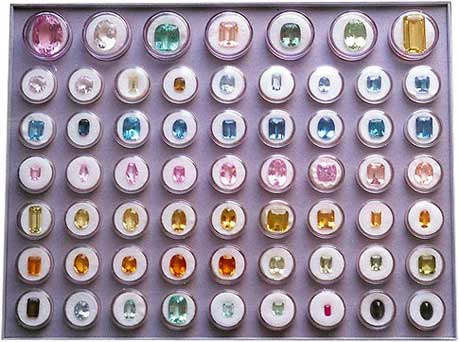 |
| This beryl group is but one of dozens that comprise the main portion of the Gübelin collection, acquired, and now being studied and profiled, by GIA. (Photo: Edward Boehm) |
Early last March, we were excited to receive a press release from GIA regarding its Gem Project. “Comprised of data collected from gemstones in the Edward J. Gübelin collection, which the Institute acquired in 2005,” the release read, “the online resource includes a photo, description and gemological properties for each sample.” Once again, we had to wait: the project wasn’t brought online until this August. The wait was worth it.
Since 2007, GIA has studied over 200 of roughly 2,800 gems (representing 225 minerals) in the collection, compiling photographs, gemological data, and data via scientific instrumentation. So far the project offers online access to PDF data sheets on beryl, garnet, spinel, tourmaline, and zircon. GIA also permits each species/group to be downloaded in a single PDF. According to GIA museum curator Terri Ottaway, about 1,000 gems from the collection are projected to be thus profiled. (Our 2006 story put the collection at 5,000 pieces, which included organic material such as pearl and amber.)
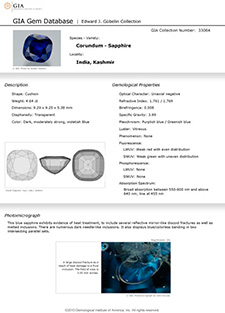 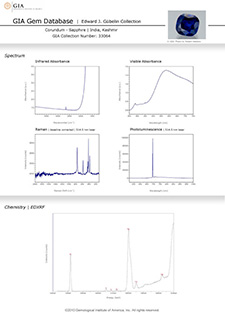 |
| This sample report contains an inclusion photomicrograph at lower left. Click the thumbnails above to see larger images. (Images courtesy GIA) |
GIA has provided a wealth of background information:
See it all at GIA Gem Project website. [back to top]
Last month, in our “bit” about a one-ton imperial jade boulder, we misidentified Phyun Phyu Myint, wife of Myint Soe, who took the photos. We regret the error and have made the correction. As Myint so aptly put it to his friend Bill Larson, “I think you need a good glass with proper power or you may have to reflash your memory.” Bill is at the Denver show this week, and, as I witnessed Tuesday night at dinner, was availing himself of at least one glass with “proper power.” —David Hughes
 |
| Purple pear. Did you know that a select few of Pala’s jewels are available to the general public? You don’t have to be a member of the trade to purchase this intriguing 8.44-carat hackmanite from Burma. Look for it in Pala’s Collector’s Corner. (Photo: Wimon Manorotkul) |
[back to top]
I know it’s heavy, I know it ain’t light
But how you gonna lift it with your arms folded tight?—Arcade Fire, “Month of May”
After our August appeal to “dig deep” to aid the people of flood-ravaged Pakistan, we received a note from Antoinette Matlins, the renowned gem and jewelry expert, author, and lecturer.
Antoinette has spent a lot of time in Pakistan and counts among her friends those in positions of influence. She is working with her friends to funnel funds directly to local NGOs, saving time and lives. She can coordinate donations through the Woodstock Area Jewish Community (WAJC), a 501 (C) (3) local to her in Vermont, so contributions can remain tax deductible. Contact Antoinette via her website: antoinettematlins.com (link at bottom of page).
Here’s what Antoinette told us about her aid project…
I’m working with two women in particular:
They are both working with local NGOs, with distribution facilitated in part by the military, in a much faster manner than that delivered by other organizations.
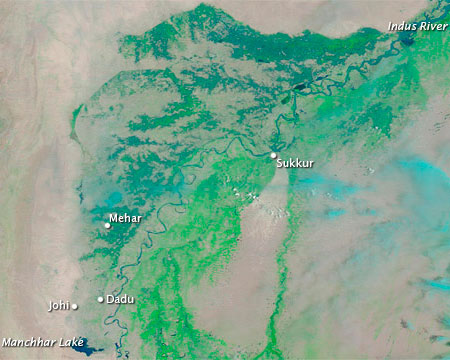 |
| Cruel blue. The Indus practically spawned a parallel river in Sindh Province by early September 2010, below, compared with fifty days earlier, July 19, above. (NASA) |
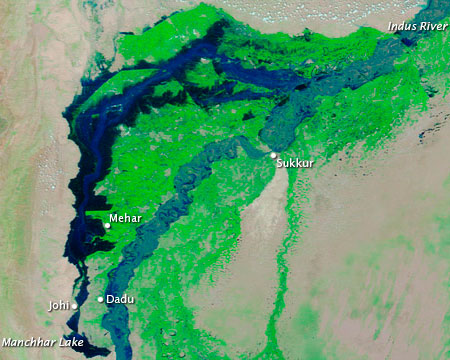 |
Okay, so you’re a little skeptical about the Pakistan military’s role in aid distribution? Read on as Antoinette tells how the NGO–military partnership worked during an earlier crisis…
This is what we did following the Kashmir earthquake. In that case, the WAJC collected the money which was wire-transferred to an account there, along with actually sending a large number of 6-person “extreme condition tents,” water collection/purification equipment, blankets, sleeping bags, etc., via UPS, which was received by Rubina and Zeba, who had organized student volunteers from the University’s mountain climbing and trekking club. Rubina was able to secure military transport for the shipment and for the students, who were then taken as far as the military transports could reach. Then the students hand carried everything into the areas hardest hit—beyond reach of most organizations.
We urge our readers to take Antoinette Matlins up on her offer to help. Contact her via her website: antoinettematlins.com (link at bottom of page). [back to top]
Recent stories of interest…
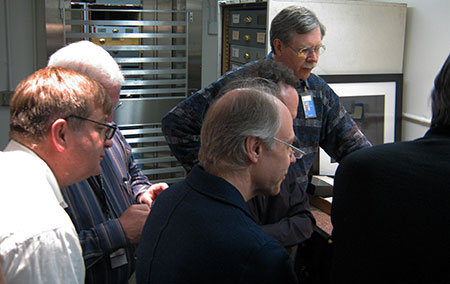 |
| In the blue room. From Gary Roskin’s series, experts rub elbows in tight quarters, taking their turn with the Hope and Wittelsbach-Graff diamonds. Left to right, Robert Weldon (GIA), James Butler (U.S. Naval Research Lab), John King (GIA), John Hatleberg (master lapidary), Jeffrey Post (Smithsonian), Henri Barguirdjian (Graff USA). See also an abstract of John King’s Bangkok show presentation “The Allure of Colored Diamonds.” (Photo: Gary Roskin) |
[back to top]
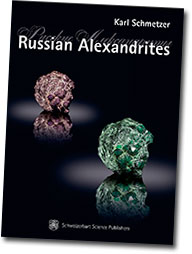 |
World-renowned mineralogist, Dr. Karl Schmetzer, has produced the definitive gemological reference book on Russian alexandrite, the color-change variety of chrysoberyl named in 1842 in honor of the Tsarevich, the future Tsar Alexander II of Russia (r.1855-81). Featuring exhaustive research by the volume editor and author, Russian Alexandrites also includes contributions by George Bosshart, Marina Epelboym, Lore Kiefert and Anna-Kathrin Malsy, and presents comprehensive discussions on
The book also presents a complete overview on historical pieces now in museum collections in St. Petersburg, Moscow, Vienna, London, Berlin and Munich.
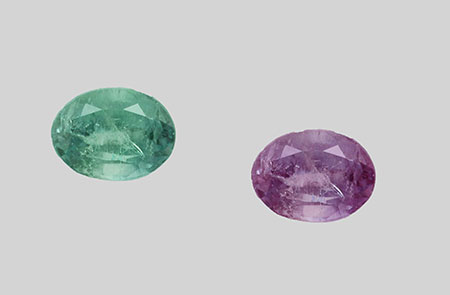 |
| Facetted Russian alexandrite with color-change from green in daylight to purple in incandescent light. This gemstone of 1.61 carats (sample from Rolf Goerlitz company, Idar-Oberstein, Germany) was examined for the present study. (Photo: K. Schmetzer) |
The history of this beautiful color-change gemstone has been shrouded in mystery and mythologizing since its discovery (fall 1833), so one of the most interesting and illuminating aspects of this beautifully illustrated volume is the documentary evidence chronicling the discovery and identification of Russian alexandrite. For the first time, this book reconstructs an accurate history of alexandrite through original letters and reports translated from Russian, French, Swedish, and German, as well as historical photographs obtained from obscure archives. The historical part of this book also provides an insight into the study of minerals of the 1830s to 1850s, when mineralogy was beginning to become a science. The book’s sumptuous illustrations and handsome layout present the technical, visual, and historical content intelligibly and thoughtfully.
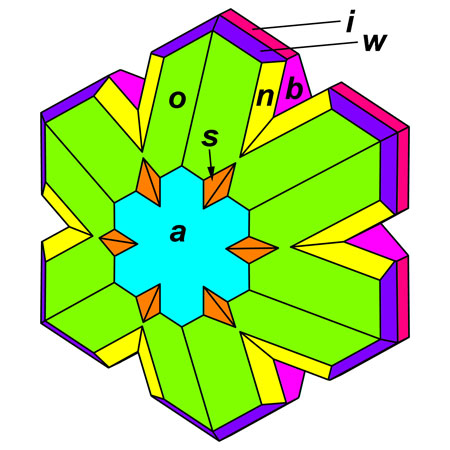 |
| Cyclic twin (trilling) with dipyramidal habit of alexandrite from Tokovaya area, Urals, Russia; the faces shown are frequently observed in material which is unearthed from the Malysheva mine. (Crystal drawing and artwork: K. Schmetzer) |
The book will be available September 21 via the publisher, Schweizerbart Science Publishers. See that link also for a full-color flyer and detailed table of contents.
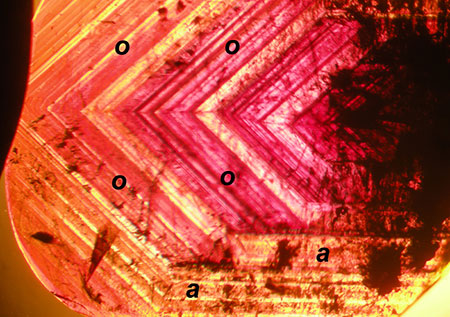 |
| Typical microscopic growth structures and pleochroism in faceted alexandrite from Tokovaya area, Urals, Russia; the growth faces represent the pinacoid a (100) and the dipyramid o (111). Immersion, polarized light, 35x. (Photo: K. Schmetzer) |
[back to top]
— End September Newsletter • Published 9/16/10 —
2015.3 | 2015.2 | 2015.1
2014.3 | 2014.2 | 2014.1 | 2013.3 | 2013.2 | 2013.1 | 2012.3 | 2012.2 | 2012.1
2011.3 | 2011.2 | 2011.1 | 2010.3 | 2010.2 | 2010.1 | 2009.3 | 2009.2 | 2009.1
2008.3 | 2008.2 | 2008.1 | 2007.3 | 2007.2 | 2007.1 | 2006.3 | 2006.2 | 2006.1
2005 | 2004 | 2003 | 2002 | 2001 | 2000
Note: Palagems.com selects much of its material in the interest of fostering a stimulating discourse on the topics of gems, gemology, and the gemstone industry. Therefore the opinions expressed here are not necessarily those held by the proprietors of Palagems.com. We welcome your feedback.